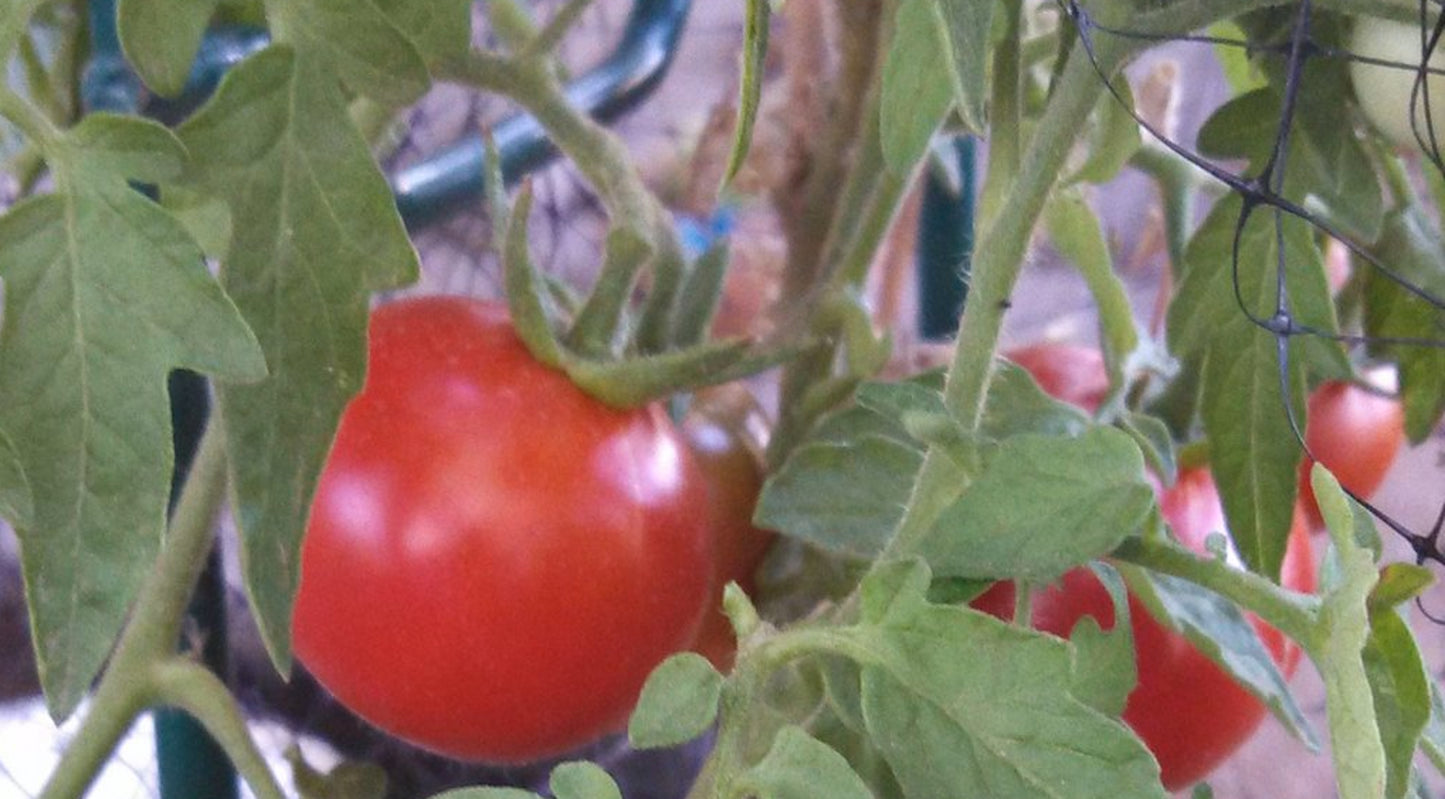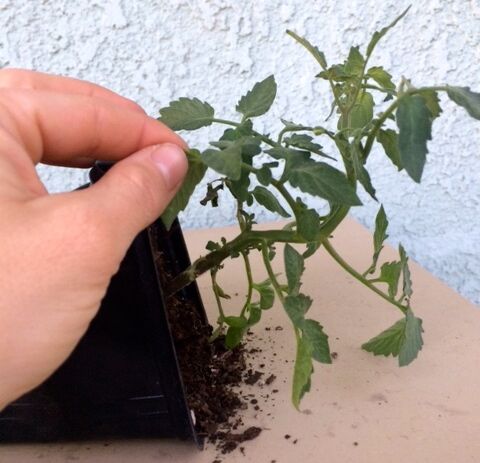
In the low desert, it is ideal to start tomatoes by seed early in the season to allow the plant to be transplanted as soon as the threat of frost is over (around early to mid March through early April in the low desert areas of Tucson). Tomato seeds need about a 6-8 week growing period before you transplant. More specifically, it is a good time to transplant when a seedling has three to four true leaves and after it has been hardened off (the process of moving plants outdoors for a portion of the day to gradually introduce them to the direct sunlight, dry air, and cold nights). When the time comes to transplant tomato starts, here are a few tips to get the most out of your plants.
By Melissa Kruse-Peeples, NS/S Education Coordinator and Laura Neff, NS/S Education Assistant
In the low desert, it is ideal to start tomatoes by seed early in the season to allow the plant to be transplanted as soon as the threat of frost is over (around early to mid March through early April in the low desert areas of Tucson). Tomato seeds need about a 6-8 week growing period before you transplant. More specifically, it is a good time to transplant when a seedling has three to four true leaves and after it has been hardened off (the process of moving plants outdoors for a portion of the day to gradually introduce them to the direct sunlight, dry air, and cold nights). When the time comes to transplant tomato starts, here are a few tips to get the most out of your plants.
CARE OF MATURE PLANTS
Selecting a Variety
Before transplanting, it is best to have some kind of plan in place. Does the variety you are transplanting include the designations of heat tolerant, arid-adapted, or dryland variety? These are important characteristics in the low desert because this means that these specific varieties are known to set fruit at 90 degrees F or higher, giving you a longer season of delicious fruit. Typically, only the smaller-sized fruit varieties will produce in hotter months in the desert. The size of both the tomato plant and fruit is a factor to consider when looking at different varieties. Are you planting in the ground or in a container? Smaller plants tend to do better in containers but typically need a 5-gallon size container or larger per plant to thrive. If you are planting in ground, a distance of 24-36 inches between each plant is ideal. The Flamenco tomato is a good choice for container gardeners as saladette-sized fruits will be produced on plants that are just 1 1/2 to 3 feet tall.
Tomato varieties are also classified into categories based on their growing habits. Indeterminate varieties are those that grow and produce flowers continually and are recommended for desert growing. They may slow down in the height of the summer but will thrive again in the late summer through fall. On the other hand, determinate varieties stop growing once flowers at the terminal bud set fruit. This means that they tend to have fruit ripen within a similar 2-week window and grow smaller plants. Determinate varieties are slightly more particular and are recommended for containers and for fall in the low desert when they can quickly produce an abundance before colder temperatures set in.
Transplanting
Before transplanting your tomato start, turn the plant on its side for a day or two; this allows the top of the plant to curl up toward the sun. Next, cut off the leaves closest to the base of the plant, leaving only the top few branches. Next, lay your tomato plant sideways in a trench big enough to let the unpruned branches stick out of the ground but that the pruned main stem can be buried. By burying more of the main stem in the ground, you’ll help them develop better vertical roots, thereby encouraging better support and a greater root zone to take up water and nutrients.
Setting Fruit
"Setting fruit" is a term describing whether or not the flowers on a plant produce fruit after pollination. Successful fruit setting means the plant has successfully produced fruit. Tomatoes are a self-pollinating/self-fertilizing species. Both male and female reproductive parts are present within each individual flower and only one plant is needed for fruit production. The anthers (male reproductive organ) and stigma (female reproductive organ) are both located within the anther cone. Sometimes the stigma protrudes out of the anther cone, making the flower more susceptible to cross-pollination from bees and other insects. This is only an issue if more than one variety is being grown and the goal of growing is to save "true to type" seed. Bees or other pollinators can assist with the pollination process by agitating the flowers, but they are not necessary.

Tomatoes start setting fruit when daytime high temperatures reach the 80s, depending on humidity. During the heat of the day and for most varieties, any temperatures above 85-90 causes pollen to become sterile. The sweet spot for ideal fertile pollen to form is when nighttime temperatures dip below 75 and gradually warm up to the mid-80s. During the late spring and summer in the low desert, temperatures are not always in this ideal zone. Therefore, selecting varieties known to do well here is important- as well as starting early in the Spring.
Humidity is also important. If it is too humid, the pollen gets too sticky. If it is too dry, the pollen is desiccated and infertile. This is another factor as to why spring and late summer/fall is ideal tomato fruit production time in the low desert. However, the plants must be large enough to be ready to set fruit, making the timing of setting out transplants critical.
If you are having difficulty and your tomatoes are flowering but not setting fruit, it is likely that heat and humidity are the culprit. You can help by shaking your tomato plants early in the morning when pollen is more likely to be viable. The agitation helps the male and female reproductive parts of the flower come into contact and allow the fruits to be fertilized. Some desert gardeners swear by using an electric toothbrush to agitate the flowers each morning. Winds are typically non-existent in the morning, and while the flowers have all the necessary parts to facilitate fertilization, they need a little movement to release the pollen to fall down to reach the stigma within the flower.
Fertilizers/Nutrients
Tomatoes thrive in well-drained and loamy soil with good quality compost. Be sure to prepare soil before any transplants are set in the ground. Compost will continue to break down and feed the plants throughout the season. Apply a few inches of mulch in April to retain moisture (mulch will also break down, thereby feeding the plants and allowing for better drainage and water retention). If using mulch, remember to water enough so that it's not just the mulch getting watered, but the roots fo the plant, too. An organic fertilizer that is high in potassium is good for fruit-setting. Banana peels and hard wood ashes are high in potassium. Nitrogen-rich fertilizers are great for promoting growth; this is important early on to get plants to size so they may support abundant flowering later on in the season.
Support
Supporting tomatoes can increase air flow and prevent leaves and fruit from sitting on the ground which can lead to disease. In their native habitat they are vining plants. Stronger central stocks have been bred into some varieties but their tendency is to have weaker stems that need support. Tomato cages are used in many gardens to help with support, but the plant must be small in order to install the tomato cage and not damage the stems. Garden stakes are an option for larger, more mature plants that do not have any supports.
Pests and Diseases
There are a few common experiences that gardeners have with tomatoes that may keep them from trying to grow them in the low desert. One of these is that the fruit tends to split. This olla irrigation system continuously feeds water directly to the roots. Another way to prevent this is to take a look at the size of tomatoes your plant produces. Smaller varieties like the Ciudad Victoria and Texas Wild Cherry tend to split less with inconsistent watering.

Blossom-End Rot is a particularly bad problem in our region. The sign that your tomatoes have this disease comes in the form of a sunken, rotten spot on the end of the tomato. This is caused by a calcium deficiency and irregular watering. While we have a lot of calcium in our native soils, it is not bio-available calcium. Add gypsum, egg shells, or epsom salts to your soil and keep watering consistent. End rot is a nasty problem when seen but it is something that can be reversed. There is no need to ditch the entire plant. However, the individual fruits that show symptoms cannot be recovered.
A major pest that enjoys tomatoes just as much as we do are tomato hornworms (Manduca quinquemaculate). Hornworms can be a tricky pest to spot but they are sure to leave clues everywhere. The clue that most people notice are large holes in a plant's foliage. Hornworms have also been known to eat the flowers and fruit as well. Because they are voracious eaters, they also leave behind recognizable poop.
If you are consistent as well as patient, hand picking hornworms off your plants is a good way to go. They do tend to camouflage themselves pretty well so if you see leaves missing give a thorough inspection. Hornworms cannot sting and are not dangerous to touch. To prevent a hornworm infestation, there are a few tactics you can implement into your gardening routine. Before planting, make sure to till your soil to destroy the overwintering larvae. You can also plant companion plants among your tomatoes that keep the hornworm moth away from your garden. These plants include basil, marigolds, and dill. In the low desert, hornworms make their appearance in late summer. The caterpillars do transform into sphinx moths that serve important pollinator functions. Therefore consider setting them free in another location rather than just ending their existence. They feed on any plant in the nightshade (Solanaceae) family. Some gardeners move hornworms to potato or tobacco plants. They will also consume devil's claw (Proboscidea species) and it is an easy option to plant as a trap crop.
Lastly, the lack of fruit-setting is a common note many gardeners in the low desert make when it comes to their tomato plants. See paragraph titled Setting Fruit for specifics on how to adjust your technique.
If taken care of properly, tomato starts can give a gardener a sense of instant gratification and accomplishment that can last for years to come.




